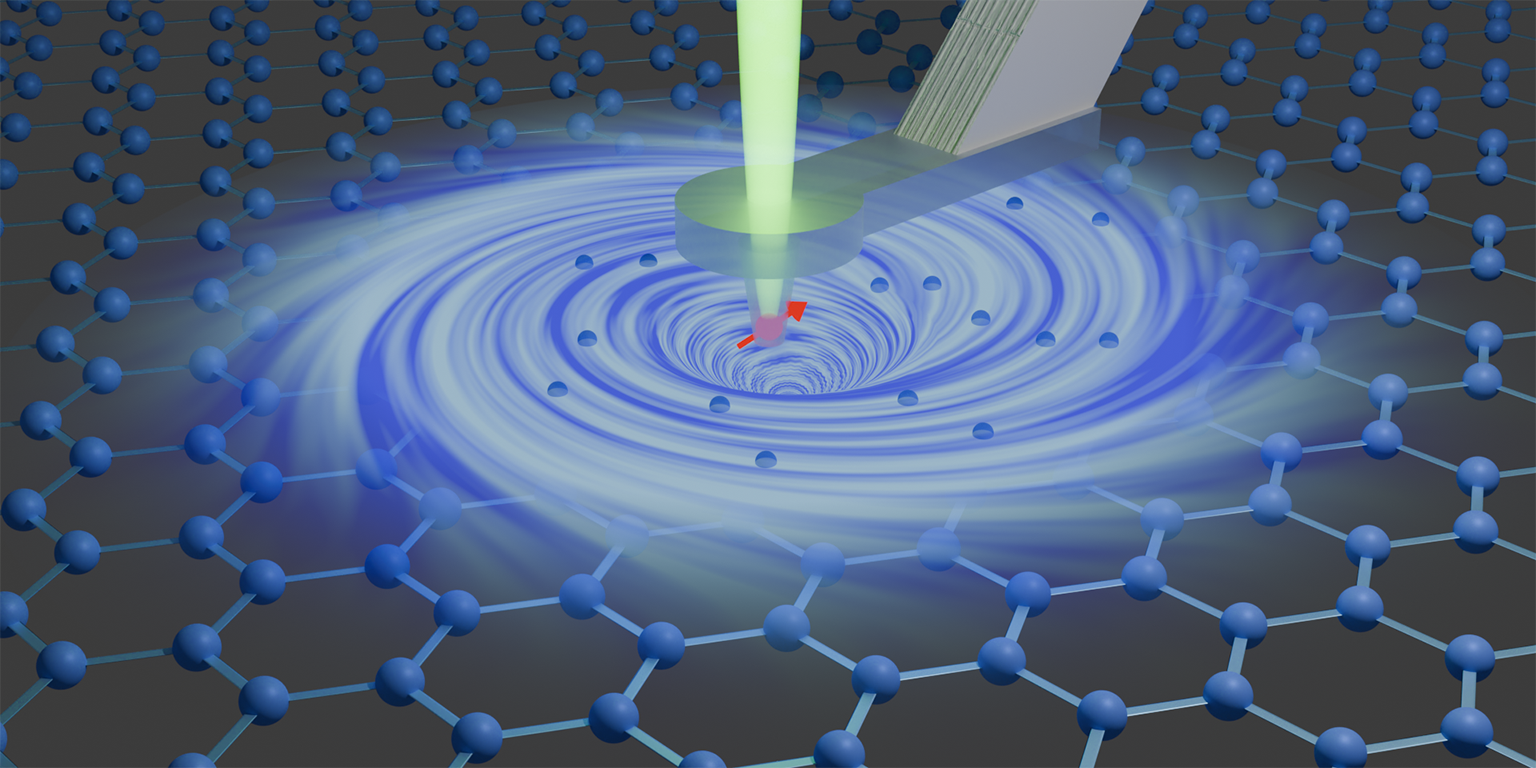Reviewed by Lexie CornerMay 14 2024
Researchers at ETH Zurich have successfully detected electron vortices in graphene for the first time using a high-resolution magnetic field sensor. The study was published in the scientific journal Science.
 Using a magnetic field sensor (red arrow) inside a diamond needle, researchers at ETH imaged electron vortices in a graphene layer (blue). Image Credit: Chaoxin Ding
Using a magnetic field sensor (red arrow) inside a diamond needle, researchers at ETH imaged electron vortices in a graphene layer (blue). Image Credit: Chaoxin Ding
An ordinary electrical conductor, like a metal wire, is accelerated by the electric field the battery creates when it is connected to another electrical conductor. Electrons in motion often collide with vacancies or impurity atoms in the wire's crystal lattice, converting some of their motion energy into lattice vibrations. Heat is produced during this process, which is felt, for example, when one touches an incandescent lightbulb.
Collisions between electrons are much less common than collisions with lattice impurities, which occur frequently. However, things get different when graphene—a single layer of carbon atoms arranged in a honeycomb lattice—is utilized instead of regular iron or copper wire. Impurity collisions are uncommon in graphene, with electron-to-electron collisions being the most common type. The electrons act more like a viscous liquid in this situation. Therefore, the graphene layer should experience well-known flow phenomena like vortices.
ETH Zurich researchers, led by Christian Degen, used a high-resolution magnetic field sensor in their experiment.
Highly Sensitive Quantum Sensing Microscope
During the fabrication process, Degen and colleagues attached small circular disks forming vortices to a conducting graphene strip that was only one µm wide. The disks ranged in diameter from 1.2 to 3 µm. According to theoretical calculations, electron vortices should form in smaller disks, not larger ones.
The researchers measured the tiny magnetic fields created by the electrons flowing inside the graphene to visualize the vortices. For this purpose, they employed a quantum magnetic field sensor with a nitrogen-vacancy (NV) center embedded in the diamond needle tip.
The NV center, as an atomic defect, exhibits quantum behavior, with its energy levels contingent upon an external magnetic field. Laser beams and microwave pulses can make the center’s quantum states as sensitive to magnetic fields as possible. The researchers were able to precisely determine the strength of those fields by reading out the quantum states using a laser.
Because of the tiny dimensions of the diamond needle and the small distance from the graphene layer–only around 70 nm–we were able to make the electron currents visible with a resolution of less than a hundred nanometers.
Marius Palm, Former Ph.D. Student, ETH Zurich
This resolution is sufficient for seeing the vortices.
Inverted Flow Direction
During their measurements, the scientists noticed a reversal of the flow direction, which is a distinctive indicator of the predicted vortices in the smaller discs. In the event of a vortex, the flow direction inside the disc is inverted, unlike normal (diffusive) electron transport, where the electrons in the strip and disc flow in the same direction. The larger discs did not show any vortices, as the calculations had predicted.
Thanks to our extremely sensitive sensor and high spatial resolution, we didn’t even need to cool down the graphene and were able to conduct the experiments at room temperature.
Marius Palm, Former Ph.D. Student, ETH Zurich
Palm and associates discovered hole carrier-formed vortices in addition to electron vortices. Through the application of an electric voltage beneath the graphene layer, researchers altered the number of free electrons, shifting the current flow away from electron carriers to vacancies, also known as holes.
The complete disappearance of vortices was observed solely at the charge neutrality point, where there existed a minimal and equilibrium concentration of both electrons and holes.
“At this moment, the detection of electron vortices is basic research, and there are still lots of open questions,” said Palm.
For example, scientists still need to determine the effects in even smaller structures and how electron collisions with graphene's borders affect the flow pattern. The ETH researchers' novel technique for detecting electron transport effects in mesoscopic structures allows for a closer examination of numerous other unusual electron transport phenomena, which can occur on length scales ranging from several tens of nm to a few µm.
Journal Reference:
Palm, M., et al. (2024) Observation of current whirlpools in graphene at room temperature. Science. doi.org/10.1126/science.adj2167.